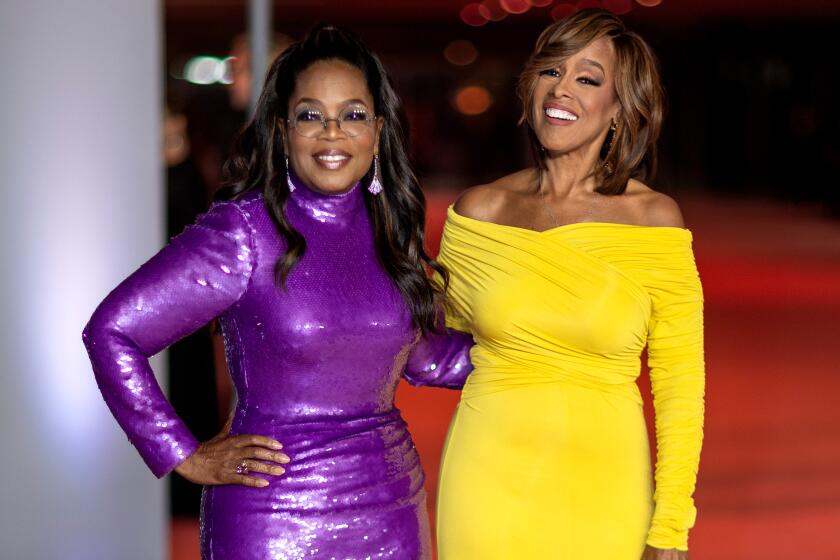Putting a Face on War : Images: It’s one thing for newscasts to speculate on military strategy as if the gulf crisis were a $24.95 board game. It’s quite another thing to show those who will be under fire.
A young soldier in fatigues faces an NBC “Today” camera in the Saudi desert, smiling as he greets his fellow citizens in the United States.
Click .
In Illinois, just-activated reservists Capt. Priscilla Smith and Staff Sgt. Doug Martin are being interviewed on “CBS This Morning” about the call-up’s impact on their families. In the case of Smith, whose husband is already serving in the Persian Gulf, the concern is who will now care for their three children?
Click .
“I’m a college kid back home,” a baby-face Marine in battle gear says somberly on ABC’s “Good Morning America.”
This video prelude to actual conflict has gone on for months, and thank goodness for it.
Yes, television news has always been picture happy, using those pictures to melodramatically dwell on life’s soap operas while seating us front row center for the greatest spectacles of our time. Yet, hampered by restrictions placed on the media, what TV has done best during the gulf crisis--what no other medium could do as well or as extensively--is put a human face on war.
The war that seems to be coming.
On the one hand, these continual two-way video postcards between the war and home fronts are ripe for parody, as “Saturday Night Live” proved recently with a savagely funny rendition of a GI in the gulf region endlessly talking on TV with his family in the United States.
On the other hand, who better to fill U.S. television currently than U.S. troops, and their loved ones, whose lives and futures may be in greater jeopardy following today’s midnight Eastern standard time (9 p.m. Pacific time) United Nations deadline for Saddam Hussein to leave Kuwait?
Wife and husband Delta Burke of “Designing Women” and Gerald McRaney of “Major Dad” have been on TV lately talking about their recent visit with U.S. troops in the gulf. They show the usual clips of smiling stars and smiling troops. Yet the symbolism of those clips is powerful and inescapable, for you suddenly wonder just how many Americans who normally would be laughing at Burke’s and McRaney’s CBS comedies--or at “Cheers” on NBC or “Roseanne” on ABC or “The Simpsons” on Fox--are now in the gulf. And how many won’t return.
Burke’s problems with the producers of her series have made for splashy headlines. But as “CBS This Morning” co-host Harry Smith noted Monday, the “frictions of fame” now seem trivial compared with the frictions of nations.
And the fates of potential combatants.
It’s one thing for TV newscasts to engage in impersonal war exercises as they do--to pointlessly speculate on military strategy by moving around little toy tanks and artillery on miniature Middle East maps as if the gulf crisis were a $24.95 board game. It’s quite another thing to show, as they also do, the faces those who will be in the tanks or facing the artillery.
A picture is worth a thousand statistics.
It’s important, for example, that in addition to reading and hearing about it, that Americans see for themselves how minorities are serving in the gulf far out of proportion to their population, how the people militarily representing the U.S. are those who are usually served least by the United States.
It’s important that we see for ourselves that 11% of U.S. forces in the gulf are female and that the numbers of females assigned to cover this possible war as journalists--CNN’s dependable Christiane Amanpour has been on the story since a few days after Iraq’s Aug. 2 invasion of Kuwait, for example--would far exceed that for past wars.
Faces.
* The faces of Congress in a heartfelt debate of war and peace and national interest, with a minimum of partisan rhetoric, provided a sense of the historic that was overwhelming.
* The faces of war protesters, visible in news footage, are still underrepresented among the talking heads of news interview shows.
* The faces of the enemy are blurry. That is, the enemy whose “butt” the troops say they are going to kick.
Many Americans who see the just-released movie thriller, “Not Without My Daughter,” may now view all of Islam as the enemy, perhaps not distinguishing between the brutal Iranians depicted on the movie screen and the Arabs shown on the TV screen, to say nothing of this nation’s many Arab Americans.
Timing is everything, and regardless of its merits as drama, the timing of “Not Without My Daughter”--its release at such a volatile time--just stinks. It’s greed at its worst.
There is already too much dangerous culture bashing going on.
Somebody told me about a joke he heard on TV recently. The question: What do Hiroshima, Nagasaki and Baghdad have in common? The punch line: “Nothing . . . yet !”
Not . . . funny.
Comics now “kicking butt”? The Fox comedy series “In Living Color” is “kicking butt.” In a Sunday sketch, it presented its own “Arab Elvis” mocking Arab music and dress in a demeaning caricature that was comical only if you found Arab culture comical.
In addition, the World Wrestling Federation, as always, is “kicking butt.”
On consecutive weekly “WWF Superstars of Wrestlings” telecasts on KTTV, that burlesque crazy man Sgt. Slaughter whipped crowds into frenzies by wearing a checkered scarf or Kefiyeh on his head and feigning devotion to Saddam Hussein.
Although most viewers will surely understand that Sgt. Slaughter is playing this for laughs, some will not, and it’s exactly such slurs against Arabs--as if they all supported Hussein--that feeds bigotry and potential violence against Arab Americans.
At a Jewish prayer service I attended recently, a man stood and prayed for the safety not only for U.S. troops in the gulf and their allies, but also for Iraqi soldiers. “They’re loved by someone, too,” he said.
Humanizing and putting a face on your enemy takes courage.
The point was amplified Sunday night during a repeat showing of a powerful PBS “Frontline” documentary on the massacre of hundreds of innocent civilians by U.S. Marines in the Vietnamese village of My Lai 23 years ago.
The men were told that the village contained Viet Cong or Viet Cong sympathizers and were ordered to kill everyone there. One of the former Marines on the scene now recalls: “We understood that we were gonna go in, there was gonna be a helluva fight, and we were gonna kick some ass.”
And so the men of Charlie Company--with only a few refusing to take part-- slaughtered the unarmed inhabitants, many of whom were women and small children, at breakfast time. A now emotionally wrecked former Marine who participated confesses on screen to personally killing 25 villagers, including shooting in the back a fleeing woman he thought was carrying a weapon. When he turned her over, he saw instead she had been carrying a baby, now also dead.
He still has nightmares about it. “The whole program of killing--it just came out,” he says. Later he adds: “War’s not sometimes you shoot at me, sometimes I shoot at you. War is terrible. That’s why we don’t need another war.”
Meanwhile, the U.N. deadline approaches. And television, which lives by the clock, is now watching it closer than ever.
The complete guide to home viewing
Get Screen Gab for everything about the TV shows and streaming movies everyone’s talking about.
You may occasionally receive promotional content from the Los Angeles Times.



